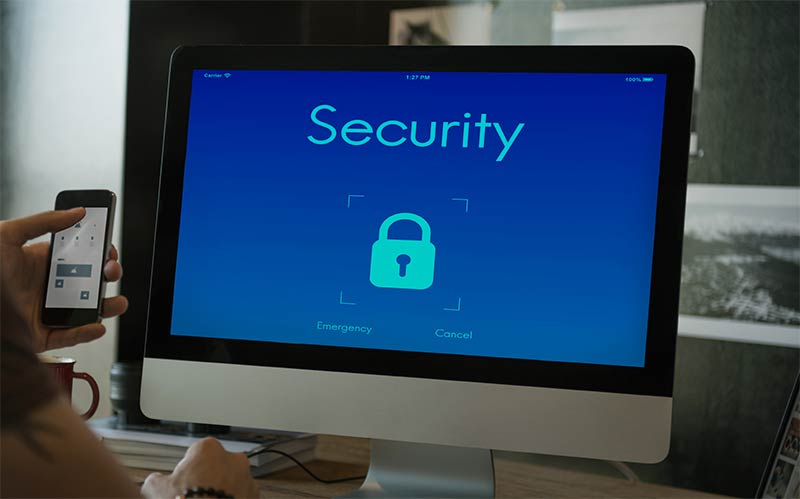BlueFletch's Enterprise Mobility Roundup Podcast recently spoke with Justin Beals, CEO of Strike Graph on the state of security and compliance issues.

Security Trends
Outdated legacy systems, security protocols, and device mismanagement are a few areas of concern. Therefore, as new vulnerabilities emerge every day, consumers continue to be weary of where they shop. So much personal data is involved in the transaction process that some customers are beginning to lose trust in the enterprise as more data leaks occur.
Looking ahead to the new year, organizations must assess their existing protocols and consider revitalizing their security processes.
Trust and Data Sharing
Trust is the foundation upon which sales are generated. It is the highest form of currency within the enterprise, and without a sense of trust in a company, a consumer is unlikely to feel confident making a purchase.
With 70% of Americans shopping digitally, security standards must continue to secure sensitive information.
This trust is continuously pressured by data security, thieves, hackers, and other external and internal threats. With 70% of Americans shopping digitally, security standards must continue to secure sensitive information.
Hundreds of millions of names, addresses, and credit card numbers are passed annually. As a result, hackers have a higher chance of exploiting weaknesses to access data. Organizations must prove to consumers that this information is safe when shopping with them.
Customers need to know an organization’s network is not vulnerable to attack when shopping online. This is where security certifications such as the ones SOC 2 and ISO 27001 provide come into play.

Security Certifications and Standards
A security certification is a designation that verifies that an organization has implemented specific security controls and processes to protect sensitive information.
In the digital marketplace, security certifications are necessary to assure customers, partners, and regulators that the organization is taking the necessary steps to protect sensitive information and comply with industry standards and regulations.
Customers and clients need to know they can trust an organization from the get-go. Therefore, a security certification serves as a public assurance badge to inform consumers and other necessary parties that an organization cares about data security.
Security certifications such as SOC 2 help build consumer trust and demonstrate an organization’s commitment to security. Also, they provide third-party validation of the organization’s security practices, which can be valuable in risk management and regulatory compliance efforts.
In today’s digital world, where data breaches and cyber-attacks are becoming more frequent, having a security certification can also provide a competitive advantage for organizations in the marketplace.
SOC 2 Certification
SOC 2 is a security certification for organizations that handle sensitive data, such as financial or personal information. It’s based on the Auditing Standards Board of the American Institute of Certified Public Accountants’ (AICPA) Trust Services Criteria (TSC).
The certification verifies that the organization has implemented appropriate technical and organizational controls to secure that data. The audit process evaluates the design and effectiveness of the controls against the five Trust Services Criteria:
- Security
- Availability
- Processing Integrity
- Confidentiality
- Privacy
SOC 2’s report is intended for use by the organization’s management, customers, and other stakeholders who need assurance about the security of sensitive data. Also, when audited regularly, organizations can continue to stay up-to-date with the latest best practices.
Getting Certified with SOC 2
SOC 2 conducts annual security audits to monitor an organization’s security posture. To begin the certification process, and organization must first choose a SOC 2 standard that matches its needs (i.e., Security, Availability, Confidentiality, Privacy, or Processing Integrity).
Next, assess current information security controls and determine which ones align with the chosen standard. Implement any necessary changes to these protocols to align with the bar entirely.
To begin the official auditing process, and organization must look for an independent auditor, such as Strike Graph, to perform the SOC 2 audit. The auditor will assess and issue a report. TThe report and organization will address any findings or issues that conflict with SOC 2’s standards.
Once all issues have been addressed, the auditor will issue a SOC 2 report attesting to the conformity of the protocols with the chosen standard.
To maintain SOC 2 certification, an organization must undergo periodic audits to ensure its standards continue to meet the requirements of SOC 2.
The ISO 27001 Standard
ISO 27001 is a globally recognized information security standard that outlines a systematic approach to managing sensitive information, including personal data and confidential business information. It provides a framework of policies, procedures, and controls that organizations can implement to secure their information assets and reduce the risk of data breaches and other security incidents.
In addition, organizations that handle sensitive information, such as financial institutions, healthcare providers, and government agencies, may be required to comply with ISO 27001 as part of their regulatory obligations. The standard can also help organizations meet security and privacy regulations, such as the EU’s General Data Protection Regulation (GDPR).
ISO 27001 certification provides organizations with a recognized framework for information security. It helps build trust in the organization’s security posture, making it a valuable asset in the digital marketplace.
Getting Certified with ISO 27001
An organization can choose to be audited annually for ISO 27001 compliance. These audits are conducted by a third-party auditor, such as Strike Graph, to assess the organization’s security standards.
Where SOC 2 gives you a guideline of standards to meet, ISO 27001 outlines specific criteria that must be implemented to comply. Therefore the auditing process begins with an internal gap analysis of the current information security management system (ISMS) against the requirements of ISO 27001.
From here, the ISO 27001 requirements must be implemented within an organization. This includes developing policies, procedures, and controls to ensure information confidentiality, integrity, and availability.
To be ISO 27001 certified requires a secondary certification party to work alongside the initial third-party organization. This is because ISO cannot directly approve an organization. So an organization must seek out an accredited certification body to conduct the audit.
Next, address any non-conformities identified during the assessment and provide evidence of corrective actions. If the certification body finds the ISMS meets the requirements of ISO 27001, it will issue a certificate of conformity.
The certification process can take three years as an organization must complete several audits to qualify for full certification. Therefore, to maintain ISO 27001 certification, periodic surveillances and recertification audits every three years are necessary.
Building Security for the Consumer
Building a security posture that aligns with their environment’s needs, risks, and unique factors is crucial. Every company has different business standards that contribute to how effective its security posture is.
Essential factors to consider include the amount of information needed to conduct business, what information is being exchanged (credit card numbers, addresses, etc.), and how that information is stored.
This information is at risk every day without a robust security standard. For a multi-million dollar retail corporation with thousands of customers enrolled in company accounts. This is why seeking certifications like SOC 2 can also be necessary for learning and maintaining best practices.
Not only do customers have peace of mind knowing an organization audits and assesses annually, but management feels confident knowing its posture is adequately maintained. Think of it like getting an annual car inspection for your safety and those on the road.
From a consumer’s perspective, each industry needs to build trust differently. Consumers, clients, and business partners want to know that an organization continues to create an adequate, secure standard.

Internal Best Practices
Shared device environments open many new opportunities for hackers and thieves to breach, access, and leak data systems.
Consider how much information is accessible on a handheld device in the field. Employee information? Client data? Is this device used for transactions? Does it access a not-so-secure network with vulnerable customer data?
Now consider how safe this information is in a handheld device that can be just as easily stolen as lost. Lost and stolen devices are a burden to any organization that leverages shared devices. Without tools like a device finder, an organization may spend thousands per year re-deploying new devices.
But that’s only a portion of the cost of those devices that leaks sensitive information. As we’ve seen over the last few years, data breaches are becoming more common among large retail enterprises.
Stopping these attacks begins by developing internal security practices that protect devices from being accessed. Tools such as SSO, device lockdown, and analytics reports (login/logout data, location information, etc.) help mitigate the likelihood of an attack.
Furthermore, complying with industry-standard data security protocols and pursuing annual security audits can prove fruitful for maintaining nutritional standards.
Conclusion
There is no better time to begin adopting new security standards than now. The way we do business will continue to evolve, so building a secure foundation now will only make adapting to future changes easier. Keep consumers in mind when evaluating security practices. After all, they’re the ones who keep the ship afloat. Maintaining a secure data storage system and showing consumers you care is the best way to build trust.
For a more in-depth conversation about the state of security, check out our interview with Justin Beals of Strike Graph on the Enterprise Mobility Roundup Podcast.
